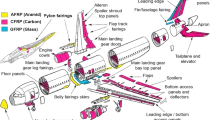Abstract
Nomex honeycomb core has been widely applied in aerospace industries due to its superior strength and rigidity. However, the machining defects of honeycomb core can deteriorate the bonding strength between honeycomb core and connective face sheet. This paper investigates the tearing defects formatted in milling process of Nomex honeycomb core. Firstly, a cutting force model is proposed to predict the milling forces under various tool entrance angles. Then, finite element simulation for machining honeycomb wall is conducted to reveal the formation mechanism of tearing defects. The accuracy of the model is verified by a group of experiments under different entrance angles and the relative error is below 25% in 1-direction and 20% in 2-direction. It is found that the formation of tearing defects is closely related to the deformation of honeycomb wall and the component of cutting force in direction parallel to wall. The tool entrance angle can be thus optimized based on the reduction of tearing defects. The optimized entrance angle of double wall is among 40° and 70°.












Similar content being viewed by others

Data availability
The data and material in this paper are available from the corresponding author on reasonable request.
References
Bitzer T (1997) Honeycomb technology. Springer, Netherlands
Herrmann AS, Zahlen PC, Zuardy I (2005) Sandwich structures technology in commercial aviation. In: Sandwich structures 7: advancing with sandwich structures and materials. Springer-Verlag, pp 13–26
Hexcel Composites (1999) HexWeb honeycomb attributes and properties
Zenkert D, Nordic Industrial Fund. (1997) The handbook of sandwich construction
Liu Y, Liu W, Gao W, Zhang L, Zhang E (2019) Mechanical responses of a composite sandwich structure with Nomex honeycomb core. J Reinf Plast Compos 38:601–615. https://doi.org/10.1177/0731684419836492
Liu L, Wang H, Guan Z (2015) Experimental and numerical study on the mechanical response of Nomex honeycomb core under transverse loading. Compos Struct 121:304–314. https://doi.org/10.1016/j.compstruct.2014.11.034
Roy R, Kweon JH, Choi JH (2014) Meso-scale finite element modeling of Nomex™ honeycomb cores. In: Advanced Composite Materials. pp. 17–29
Xiang C, Yujie W, Chao S, Xin S (2019) Research on high efficiency and low destructive manufacture process of complex structure honeycomb core. IOP Conf Ser Mater Sci Eng 538. https://doi.org/10.1088/1757-899X/538/1/012017
Ahmad S, Zhang J, Feng P, Yu D, Wu Z, Ke M (2020) Processing technologies for Nomex honeycomb composites (NHCs): a critical review. Compos Struct 250:112545. https://doi.org/10.1016/j.compstruct.2020.112545
Khan S, Loken HY (2007) Bonding of sandwich structures the facesheet/honeycomb interface a phenomenological study. In: International SAMPE Symposium and Exhibition (Proceedings). pp 1–9
An Q, Dang J, Ming W, Qiu K, Chen M (2019) Experimental and numerical studies on defect characteristics during milling of aluminum honeycomb core. J Manuf Sci Eng Trans ASME 141. https://doi.org/10.1115/1.4041834
Zhang X, Dong Z, Wang Y et al (2017) Charization of surface microscopic of Nomex honeycomb after ultrasonic assisted cutting. Jixie Gongcheng Xuebao/J Mech Eng 53:90–99. https://doi.org/10.3901/JME.2017.19.090
Foo CC, Chai GB, Seah LK (2007) Mechanical properties of Nomex material and Nomex honeycomb structure. Compos Struct 80:588–594. https://doi.org/10.1016/j.compstruct.2006.07.010
Roy R, Park SJ, Kweon JH, Choi JH (2014) Characterization of Nomex honeycomb core constituent material mechanical properties. Compos Struct 117:255–266. https://doi.org/10.1016/j.compstruct.2014.06.033
Jaafar M, Atlati S, Makich H et al (2017) A 3D FE modeling of machining process of Nomex® honeycomb core: influence of the cell structure behaviour and specific tool geometry. In: Procedia CIRP. pp 505–510
Sun J, Dong Z, Wang X, Wang Y, Qin Y, Kang R (2020) Simulation and experimental study of ultrasonic cutting for aluminum honeycomb by disc cutter. Ultrasonics 103:106102. https://doi.org/10.1016/j.ultras.2020.106102
Qiu K, Ming W, Shen L, An Q, Chen M (2017) Study on the cutting force in machining of aluminum honeycomb core material. Compos Struct 164:58–67. https://doi.org/10.1016/j.compstruct.2016.12.060
Xiang D, Wu B, Yao Y, Liu Z, Feng H (2019) Ultrasonic longitudinal-torsional vibration-assisted cutting of Nomex® honeycomb-core composites. Int J Adv Manuf Technol 100:1521–1530. https://doi.org/10.1007/s00170-018-2810-3
Yip-Hoi DM, Gill DD (2018) Investigation and modeling of flag generation in honeycomb sandwich panel machining. In: ASME International Mechanical Engineering Congress and Exposition, Proceedings (IMECE)
Marusich TD (2001) Effects of friction and cutting speed on cutting force. In: American Society of Mechanical Engineers, Manufacturing Engineering Division, MED. pp 115–123
Seemann R, Krause D (2017) Numerical modelling of Nomex honeycomb sandwich cores at meso-scale level. Compos Struct 159:702–718
Hashin Z, Rotem A (1973) A fatigue failure criterion for fiber reinforced materials. J Compos Mater 7:448–464. https://doi.org/10.1177/002199837300700404
Funding
This work was supported by the National Key Research and Development Program of China (grant numbers 2019YFB2005401), Taishan Scholar Foundation, and Shandong Provincial Natural Science Foundation of China (ZR2019MEE073 and 2019JMRH0307).
Author information
Authors and Affiliations
Contributions
Zhanqiang Liu and Jiaming Jiang conceived of the presented idea; Jiaming Jiang developed the theory and performed the computations; Jiaming Jiang and Bing Wang discussed the results and commented on the manuscript; all authors provided feedback and helped shape the research, analysis, and manuscript.
Corresponding author
Ethics declarations
Competing interests
The authors declare that they have no competing interests.
Ethical approval
It is approved that the paper is original and has been written based on the authors’ own finding. All the figures and tables are original, and every expression from other published works were acknowledged and referenced.
Consent to participate
All authors are aware and satisfied of the authorship order and correspondence of the paper.
Consent to publish
All authors are satisfied that the last revised version of the paper is published without any change.
Additional information
Publisher’s note
Springer Nature remains neutral with regard to jurisdictional claims in published maps and institutional affiliations.
Rights and permissions
About this article
Cite this article
Jiang, J., Liu, Z. Formation mechanism of tearing defects in machining Nomex honeycomb core. Int J Adv Manuf Technol 112, 3167–3176 (2021). https://doi.org/10.1007/s00170-021-06603-8
Received:
Accepted:
Published:
Issue Date:
DOI: https://doi.org/10.1007/s00170-021-06603-8



